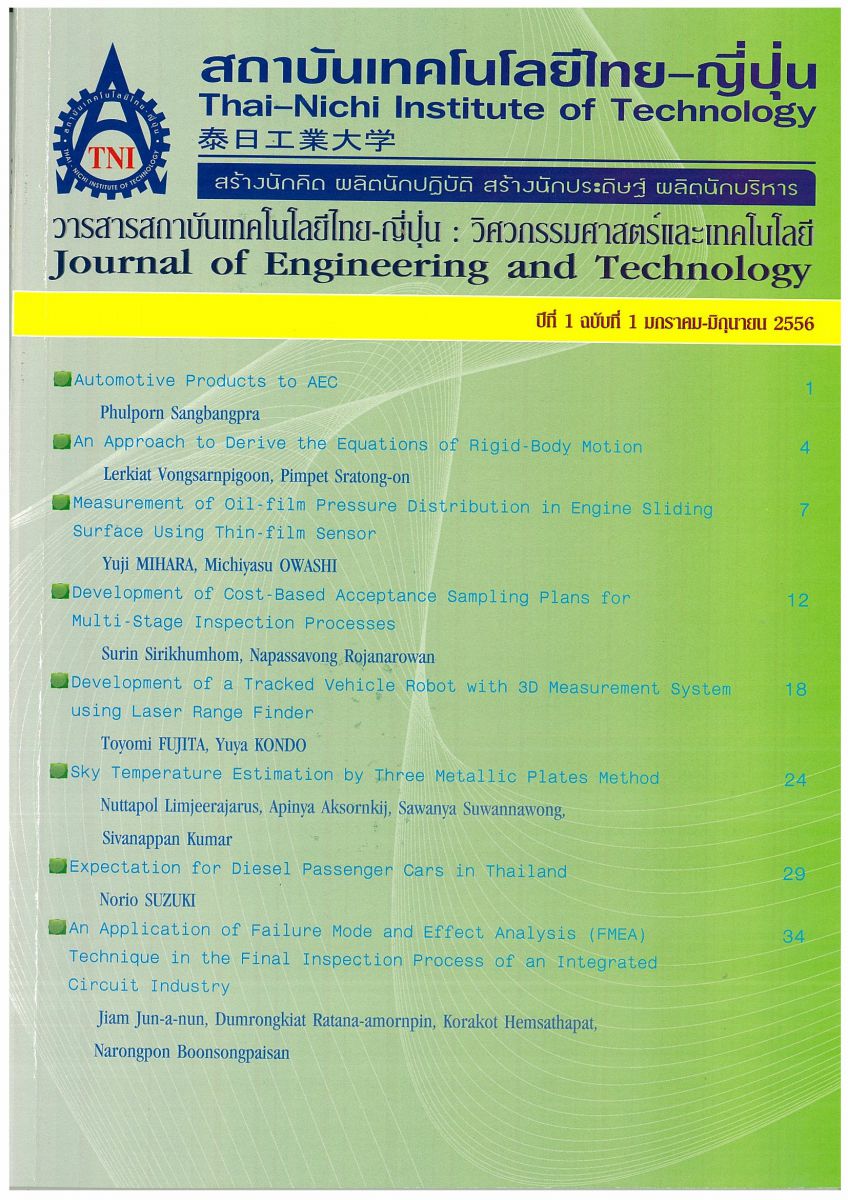Creating a Competitive Advantage by Applying Six Sigma Strategy Through Strategic Management Case Study of the Hard Disk Drive Assembly Manufacturing
Main Article Content
Abstract
Hard Disk Drive (HDD) industry has been rapidly growing with intense competition of the products such as its storage capacity, speed, and unit cost. The research was conducted to investigate the quality management issue of a company in the HDD industry with an objective to increase the percentage of Overall Yield by applying Six Sigma Strategy through Strategic Management. The study was started with an examination of current problems that effected to business, then evaluated competitive advantage, external environment and internal environment, analyzed alternative strategies, and implemented Six Sigma. Six Sigma composed of 5 steps or DMAIC as follows; 1) Define the problem, by selecting 5 highest regarding to the production volume and defective items and calculated the value of loss per month, compared with the targets and action plan. 2) Measure, by evaluating the measurement system of those 5 selected products. 3) Analysis, analyzed the cause regarding to 3G (Gemba, Gembutsu, Genjitsu), and selected Key Process Input Variable (KPIV), and created a hypothesis to identifies main variable. 4) Improve, applied Design of Experiments (DOE) to select the appropriate value of each variable 5) Control, Controlled the variables according to the goals and create a new standard. All 5 main steps are the provided to quality improvement team.
The result found that the percentage of Overall Yield was increased from 98.48% to 98.77% or 1}612}358 bath per month (19}348}296 bath per year). Another success factor was personal can analyze and make decisions under Six Sigma concept which has enabled the company to improve the quality of products and processes that can create competitive advantage in the future.
Article Details
Article Accepting Policy
The editorial board of Thai-Nichi Institute of Technology is pleased to receive articles from lecturers and experts in the fields of engineering and technology written in Thai or English. The academic work submitted for publication must not be published in any other publication before and must not be under consideration of other journal submissions. Therefore, those interested in participating in the dissemination of work and knowledge can submit their article to the editorial board for further submission to the screening committee to consider publishing in the journal. The articles that can be published include solely research articles. Interested persons can prepare their articles by reviewing recommendations for article authors.
Copyright infringement is solely the responsibility of the author(s) of the article. Articles that have been published must be screened and reviewed for quality from qualified experts approved by the editorial board.
The text that appears within each article published in this research journal is a personal opinion of each author, nothing related to Thai-Nichi Institute of Technology, and other faculty members in the institution in any way. Responsibilities and accuracy for the content of each article are owned by each author. If there is any mistake, each author will be responsible for his/her own article(s).
The editorial board reserves the right not to bring any content, views or comments of articles in the Journal of Thai-Nichi Institute of Technology to publish before receiving permission from the authorized author(s) in writing. The published work is the copyright of the Journal of Thai-Nichi Institute of Technology.
References
เฟร็ด อาร์ เดวิด (สาโรจน์ โอพิทักษ์ชีวิน แปลและเรียบเรียง) การบริหารเชิงกลยุทธ์ Concept and Cases (7th), พิมพ์ครั้งที่ 1., กรุงเทพฯ เพียร์สัน เอ็ดดูเคชั่น อินโดไชน่า จำกัด, 2550.
ตรีทศ เหล่าศิริหงส์ทอง, กลยุทธ์การผลิต/ปฏิบัติการเพื่อสร้างความได้เปรียบในการแข่งขัน, พิมพ์ครั้งที่ 1., กรุงเทพฯ: โรงพิมพ์มหาวิทยาลัยธรรมศาสตร์, 2552.
ณัฏฐพันธ์ เขจรนันทน์, การจัดการเชิงกลยุทธ์ (ฉบับปรับปรุง), พิมพ์ครั้งที่ 1., กรุงเทพฯ: สำนักพิมพ์ซีเอ็ดยูเคชั่น, 2552.
มหาวิทยาลัยโมโตโรลา, (2008). What is Six Sigma?. สืบค้นเมื่อ 4 เมษายน 2553, จาก https://www.motorola.com/Business/US-/Motorola Forest W., Implementing Six Sigma Smarter Solutions Using Statistic Methods, 1st Ed., New York: John Wiley & Sons, 2008.
Jay Heizer, Barry Render., Operations Management. 8th., New Jersey: Pearson & Prentice Hall, pp. 199-200, 2008.
Edward Abramowitz, Six Sigma for Growth. 1st Ed., Singapore: John Wiley & Sons (Asia) Pte Ltd., 2005.
Juan A. Magana-Campos and Elaine Aspinwall, “Comparative study of Western and Japanese improvement systems,” Total Quality Management., vol. 14, No. 4., 2003.
สุพานี สฤษฎ์วานิช, การบริหารเชิงกลยุทธ์: แนวคิดและทฤษฎี, พิมพ์ครั้งที่ 3., กรุงเทพณ : โรงพิมพ์มหาวิทยาลัยธรรมศาสตร์, 2553.
Fang Zhang, Shipments and revenue in Q4 will post a second consecutive period of gains. Retrived December 10, 2010, from https://www.isuppli.com/Memory-and-Storage/News/Pages/Hard-Drives-Have-a-Happy-Holiday.aspx
S. H. Park, Six Sigma for Quality and Productivity Promotion, 32th ed, Japan: The Asian Productivity Organization, 2003.
Lou Johnson, Cate Twohill. The Three Key of Six Sigma Successful. Retrieved April 04, 2010, from https://www.minitab.com


